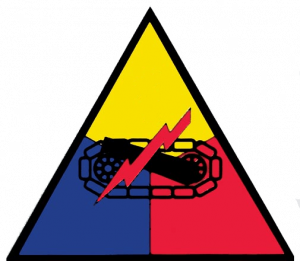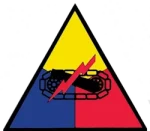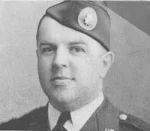Pvt. Nicholas Gugula was born on May 28, 1917, in Pennsylvania, to John and Julia Gugula and had two sisters and a brother. He completed grade school and attended high school for one year before leaving school and going to work. When the Selective Service Act became law on October 16, 1940, he registered for the draft and named his mother as his contact person. On April 21, 1941, he was inducted into the US Army in Wilkes Barre, Pennsylvania, and given the serial number 33 024 134.
He did his basic training at the Aberdeen Proving Grounds, Aberdeen, Maryland from April 24, 1941 to July 10, 1941. He then was sent to Savanah, Georgia and was stationed there from August 22, 1941, to October 13, 1941. There, he was assigned to the 454th Ordnance Company (Aviation) Bombers which was part of the 27th Bomb Group (Light). The company had six officers and 180 enlisted men. In October, the bomber group received orders to go overseas. The reality was the only places the unit could be sent were American territories mostly in the Pacific. The largest three were Alaska, Hawaii, and the Philippine Islands.
By train, the 454th was sent to San Francisco, California, where they boarded the SS President Calvin Coolidge which was a passenger ship pressed into service as a troop transport. The ship sailed for the Philippine Islands and arrived in Hawaii. After sailing from Hawaii, it took a southern route away from the main shipping lanes and while at sea, it was joined by the USAT Hugh L. Scott and the heavy cruiser the USS Louisville.
During the trip to the Philippines, smoke from an unknown ship was seen on the horizon, the Louisville’s revved its engines, its bow came out of the water, and the ship shot off in the direction of the smoke. As it turned out the unknown ship was from a neutral country. When they arrived at Guam on Sunday, November 16th, the ships took on water, bananas, coconuts, and vegetables. Although the soldiers were not allowed off the ship, they were able to mail letters home before sailing for Manila the next day. At one point, the ships passed an island at night and did so in total blackout. This for many of the soldiers was a sign that they were being sent into harm’s way. The blackout was strictly enforced and men caught smoking on deck after dark spent time in the ship’s brig. Three days after leaving Guam the men spotted the first islands of the Philippines. The ships sailed around the south end of Luzon and then north up the west coast of Luzon toward Manila Bay.
The ships entered Manila Bay, at 8:00 A.M., on Thursday, November 20th, and docked at Pier 7 later that morning. One thing that was different about their arrival was that instead of a band and a welcoming committee waiting at the pier to tell them to enjoy their stay in the Philippines and see as much of the island as they could, a party came aboard the ship – carrying guns – and told the soldiers, “Draw your firearms immediately; we’re under alert. We expect a war with Japan at any moment. Your destination is Fort Stotsenburg, Clark Field.” At 3:00 P.M., as the enlisted men left the ship, a Marine was checking off their names. When an enlisted man said his name, the Marine responded with, “Hello sucker.” Those who drove trucks drove them to the fort, while the maintenance section remained behind at the pier to unload their equipment. Some men stated they rode busses to Ft. Stotsenburg.
Nicholas’ unit was stationed at Clark Field but since the 27th Bomb Groups planes had not arrived, it is not known what they did. After the Japanese attack on December 8, 1941, the pilots were evacuated to Australia while the ground crew members of the 27th were converted to infantry and issued rifles. It was at that time that he made the decision that his skills would be of more use to the tank battalions then fighting as an infantry man. He was assigned to C Company, 192nd Tank Battalion.
The next morning the decision was made to move the battalion into a tree-covered area. Those men not assigned to a tank or half-track walked around Clark Field to look at the damage. As they walked, they saw there were hundreds of dead. Some were pilots who had been caught asleep, because they had flown night missions, in their tents during the first attack. Others were pilots who had been killed attempting to get to their planes. The tanks were still at the southern end of the airfield when a second air raid took place on the 10th. This time the bombs fell among the tanks of the battalion at the southern end of the airfield wounding some men. C Company was ordered to the area of Mount Arayat on December 9th. Reports had been received that the Japanese had landed paratroopers in the area. No paratroopers were found, but it was possible that the pilots of damaged Japanese planes may have jumped from them. That night, they heard bombers fly over at 3:00 am on their way to bomb Nichols Field.
B Company was sent to the Barrio of Dau, on December 12th, so it could protect a highway bridge and railroad bridge against sabotage. At about 8:30 am, the elements of the battalion still at Clark Field lived through another air raid. Since it was overcast, the bombers came in low and dropped their bombs which in many cases did not explode. 2nd Lt Albert Bartz, A Co., was wounded in his shoulder and had a broken clavicle. That night the 194th was sent to Calumpit Bridge.
Around December 15th, after the Provisional Tank Group Headquarters was moved to Manila, Major Maynard Snell, a 192nd staff officer, stopped at Ft. Stotsenburg where anything that could be used by the Japanese was being destroyed. He stopped the destruction long enough to get five-gallon cans of high-octane gasoline and small arms ammunition loaded onto trucks to be used by the tanks and infantry. PTG remained in Manila until December 23rd when it moved, with the 194th, north out of Manila.
A platoon of B Company tanks engaged Japanese tanks at Lingayen Gulf on December 22nd. 2nd Lt. Ben Morin and his tank crew became Prisoners of War. One member of the platoon, PFC Henry Deckert was killed when the concussion from a shell that hit near the bow gun port entered his tank and decapitated him. The other tanks were damaged by enemy fire and withdrew. The tanks were repaired and put back into service. From this time on, the tanks served as a rear guard holding roads open until all the other troops withdrew before falling back to another predetermined position to repeat the action.
A Company lost its commander, Capt. Walter Write, on December 26th. According to the story, he saw Sergeant Owen Sandmire placing landmines in the road. The mines were made by Philippine Ordnance from cigar boxes with dynamite. Write took a mine away from Sandmire and told them it looked funny. As he was placing it, it exploded in his hands. Before he died, he asked that roses be placed on his grave, but since there were no roses, the men placed a native red flower on his grave. The tanks held the position until 5:30 in the morning on December 27th when the 192nd, and part of the 194th, fell back to form a new defensive line. From there they fell back to the south bank of the BanBan River which they were supposed to hold for as long as possible. The tanks were at Santo Tomas near Cabanatuan on December 28th and 29th serving as a rear guard against the Japanese.
Just south of the river at Cabu, seven tanks of the company fought a three-hour battle with the Japanese. The main Japanese line was south of Saint Rosa Bridge ten miles to the south of the battle. The tanks were hidden in brush as Japanese troops passed them for three hours without knowing that they were there. While the troops passed, 1st Lt. William Gentry sitting on the front of his tank was on his radio describing what he was seeing. It was only when a Japanese soldier tried to take a shortcut through the brush, that his tank was hidden in, that the tanks were discovered. The tanks turned on their sirens and opened up on the Japanese.
C Company made its way south to Cabanatuan. When the company entered Cabanatuan, it found the barrio filled with Japanese guns and other equipment. For three hours, the tank company destroyed as much of the equipment as it could before proceeding south. They were at San Isidro south of Cabanatuan. It was reported at this time in local papers that one of the tank commanders stated, “During our many sallies into enemy territory, those Filipinos just rushed in front of our tanks to get at the Japs. Hell. What do they think our tanks are here for?” It was said that the Japanese tanks attacked, followed by troops, the tanks, resulting in the Japanese suffering heavy casualties.
The tanks were near Santo Tomas on the 28th and were spread out from east to west and were being bombed and shelled. A few minor injuries were reported. They were ordered to fall back to San Isidro which was located south of Cabanatuan where they were shelled again resulting in one tank being flipped onto its side when a shell landed near it. The crew was taken to a field hospital with minor injuries. The tank was put in an upright position and manned by another crew. It was noted that the tank crews were physically in poor condition from lack of sleep, lack of food, and constantly being on alert.
It was at the time that the bridge over the Pampanga River that the tanks were supposed to use was destroyed, but they were able to find a crossing through the river. At this time, C Company was re-supplied and withdrew to Baliuag where the tanks encountered Japanese troops and ten tanks. It was at Baliuag that Gentry’s tanks won the first tank victory of World War II against enemy tanks. When the tanks arrived at Baliug, the company discovered a narrow-gauge railroad bridge had not been destroyed.
It was at this time that a platoon of B Company tanks found itself on a road holding up the Japanese advance. without knowing it, five tanks took a narrow road that led to the Japanese lines. The drivers of the tanks stayed close enough so that they could see the tank in front of their tank when a shell exploded behind one of the tanks. The tanks were trapped since there was no room for them to turn around. At Ft. Knox, they were taught that if you are lost, or trapped, to double your speed. The tanks hurdled down the road running through gun nests. a roadblock, and running down Japanese soldiers. The tanks turned around, ran through the Japanese positions again, and escaped.
The next morning, December 30th, 2nd Lt. William Read's, A Co., 192nd, tank platoon was serving as a rearguard and was in a dry rice paddy when it came under enemy fire by Japanese mortars. Read was riding in a tank when one of the enemy rounds hit one of its tracks knocking it out. After escaping the tank, Read stood in front of it and attempted to free the crew. A second round hit the tank, directly below where he was standing blowing off his legs at the knees and leaving him mortally wounded. The other members of his crew carried Read from the tank and laid him under a bridge. Read would not allow himself to be evacuated since there were other wounded soldiers. He insisted that these men be taken first. He would die in the arms of Pvt. Ray Underwood as the Japanese overran the area.
On the morning of December 31st, 1st Lt. William Gentry, commanding officer of a platoon of C Company tanks, sent out reconnaissance patrols north of the town of Baluiag. The patrols ran into Japanese patrols, which told the Americans that the Japanese were on their way. Knowing that the railroad bridge was the only way to cross the river into the town, Gentry set up his defenses within view of the bridge and the rice patty it crossed. One platoon of tanks under the command of 2nd Lt. Marshall Kennady was to the southeast of the bridge, while Gentry’s tanks were to the south of the bridge hidden in huts in the barrio. The third platoon commanded by Capt Harold Collins was to the south on the road leading out of Baluiag, and 2nd Lt. Everett Preston had been sent south to find a bridge to cross to attack the Japanese from behind.
Early on the morning of the 31st, the Japanese began moving troops across the bridge. The engineers came next and put down planking for tanks. A little before noon Japanese tanks began crossing the bridge. Later that day, the Japanese assembled a large number of troops in the rice field on the northern edge of the town.
Major John Morley, of the Provisional Tank Group, came riding in his jeep into Baluiag. He stopped in front of a hut and was spotted by the Japanese who had lookouts on the town’s church steeple. The guard became very excited so Morley, not wanting to give away the tanks’ positions, got into his jeep and drove off. Gentry had told Morley that his tanks would hold their fire until he was safely out of the village. When Gentry felt the Morley was out of danger, he ordered his tanks to open up on the Japanese tanks at the end of the bridge. The tanks then came smashing through the huts’ walls and drove the Japanese in the direction of Lt. Marshall Kennady’s tanks. Kennady had been radioed and was waiting. Kennady held his fire until the Japanese were in view of his platoon and then joined in the hunt. The Americans chased the tanks up and down the streets of the village, through buildings and under them. By the time C Company was ordered to disengage from the enemy, they had knocked out at least eight enemy tanks. It appears that it was during this engagement that Nicolas was killed by enemy fire.
His parents received a telegram from the War Department around January 13, 1942.
J GUGULA
RAILROAD ST CENTRALIA PA
THE SECRETARY OF WAR DESIRES ME TO EXPRESS HIS DEEP REGRET THAT YOUR SON, NICHOLAS, WAS KILLED IN ACTION IN DEFENSE OF HIS COUNTRY ON TWENTY SIX DECEMBER IN THE PHILIPPINE ISLANDS LETTER FOLLOWS
ADAMS THE ADJUTANT GENERAL
A letter was sent to the Adjutant General’s office in Washington DC by his church’s priest asking if there was any possibility to have Nicholas’ remains returned home for burial. The Quartermaster Corps responded in a letter dated February 2, 1942, that it would be impossible to bring Nicholas home for burial. It wasn’t until May 29, 1942 that a memorial mass was held at St. Mary’s Ukrainian Greek Catholic Church remembering 53 other members of the church serving in the military and Nicholas.
In early January 1945, the American Graves Recovery Service sent out teams to recover the dead from the local cemeteries, Along the route of the march, and from isolated graves. It is not known if his remains were recovered or if his remains were never recovered. In a letter dated March 15, 1950, his mother was informed that Nicholas’ remains were unrecoverable, so when the new American Military Cemetery was opened outside of Manila, his name was placed on the Walls of the Missing in the cemetery.








